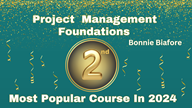How to Create a Project Decision-Making Process
 Making decisions is an integral part of project management, yet most projects are managed without a predetermined, agreed-upon approach to decision-making. Here are some tips for creating an effective decision-making process.
Making decisions is an integral part of project management, yet most projects are managed without a predetermined, agreed-upon approach to decision-making. Here are some tips for creating an effective decision-making process.
- Mirror organizational norms. Decisions are made in your organization (let’s hope so.) So, your organization’s decision-making approach should be at the core of a project’s process. For example, if people in the leadership hierarchy make decisions, then the project sponsor should make decisions about the project. And if the decision-making norm is consensus, then make decisions via consensus for a project. If decisions come after a detailed analysis and discussion, do the same for the project. That way, decision-making in projects will be comfortable and familiar to everyone involved.
- Consider the background of the sponsor and PM. The technical and business expertise of the sponsor and project manager determines how involved each is in decision-making. Who takes the lead on proposing solution alternatives and conducting analysis (beyond project management) will depend on their backgrounds. That way, the project uses those backgrounds to maximize decision-making efficiency and effectiveness.
- Include appropriate stakeholders. Include the most involved and knowledgeable stakeholders in the decision-making process. Also consider including stakeholders with significant influence or political sway who will help gain support through their involvement. Note: Select knowledgeable and influential stakeholders, regardless of whether they are part of the organizational chart. Frequently, the best organizational change agents are not part of the management team but are influential leaders who should be included in project design and decision-making.
- Ensure coverage across critical disciplines. Involve people covering the major disciplines required to deliver a project successfully. Overall, the people making decisions should have financial knowledge and authority, control over project resources, and understanding of the business and process changes the project will deliver. In addition, people with technical, legal/regulatory expertise, or contracts and vendor management should be involved as appropriate, based on the project’s scope and staffing.
Combine these choices with current and accurate project data and you’ll have a solid basis for making solid decisions.
Take a look at project documentation in your organization. Find anything that describes how to make decisions? If not, ask other project managers or someone on the leadership team about the organization’s process. Then practice by applying these tips to create a decision-making process for your current or a past project.
For more about making decisions, check out Mike Figliuolo’s Decision-Making Strategies course.
Coming Up
 My course Project Management Foundations has been updated with several text-based entries in the Table of Contents. You can read up on the hybrid project management lifecycle, get tips on creating a project information system, review a checklist for effective meetings, and more.
My course Project Management Foundations has been updated with several text-based entries in the Table of Contents. You can read up on the hybrid project management lifecycle, get tips on creating a project information system, review a checklist for effective meetings, and more.
_______________________________________
This article belongs to the Bonnie’s Project Pointers newsletter series, which has more than 91,000 subscribers. This newsletter is 100% written by a human (no aliens or AIs involved). If you like this article, you can subscribe to receive notifications when a new article posts.
Want to learn more about the topics I talk about in these newsletters? Watch my courses in the LinkedIn Learning Library and tune into my LinkedIn Office Hours live broadcasts.

Leave a Reply
Want to join the discussion?Feel free to contribute!